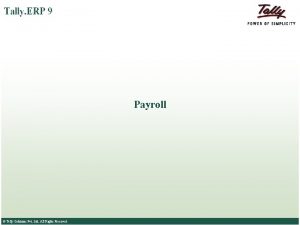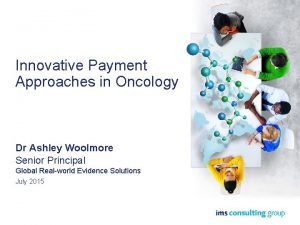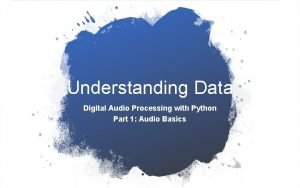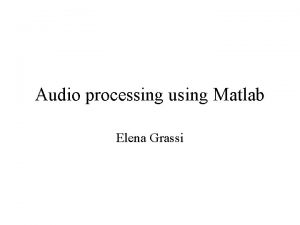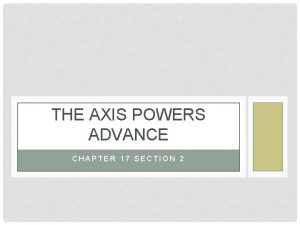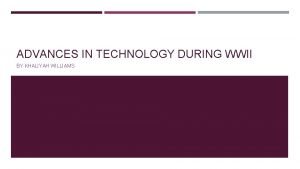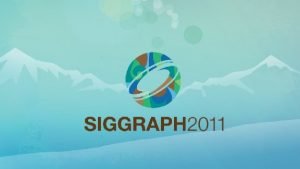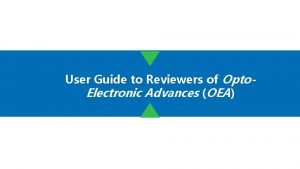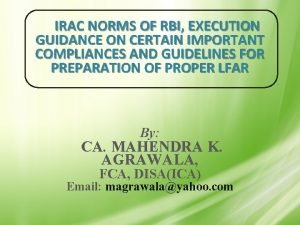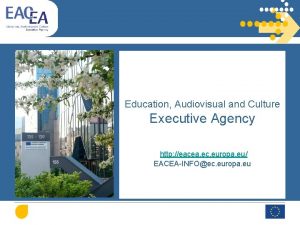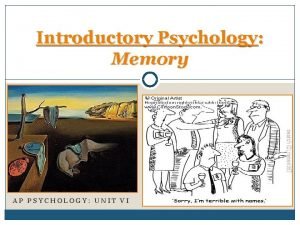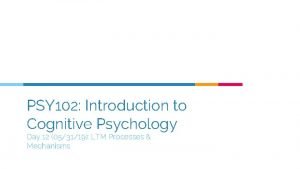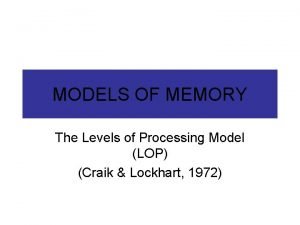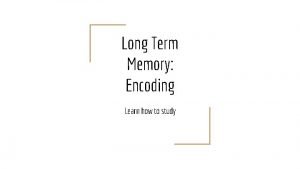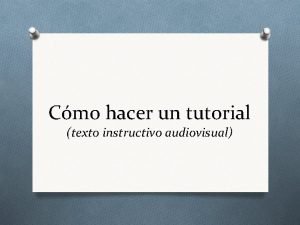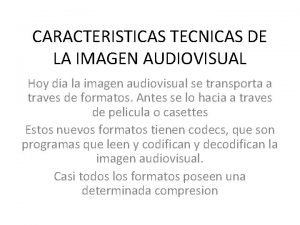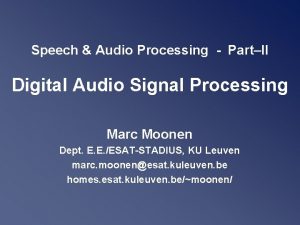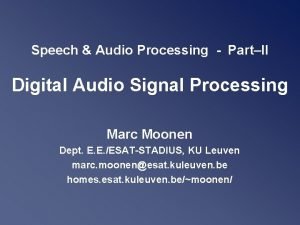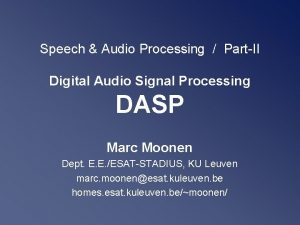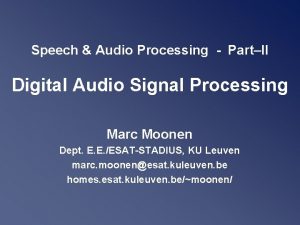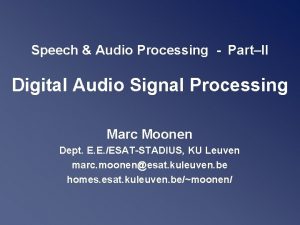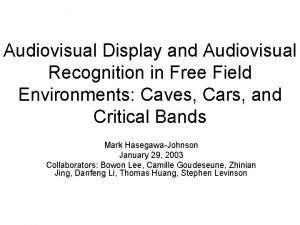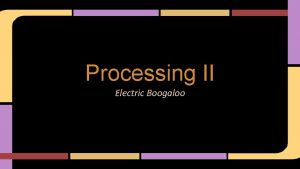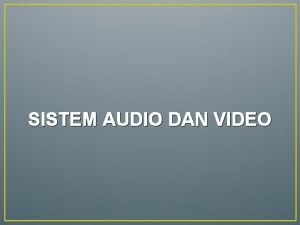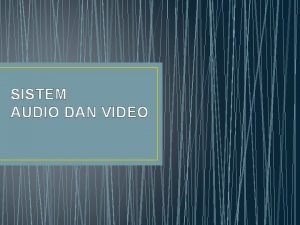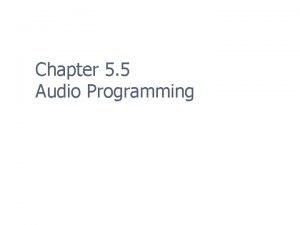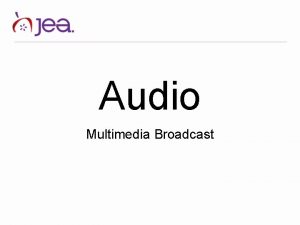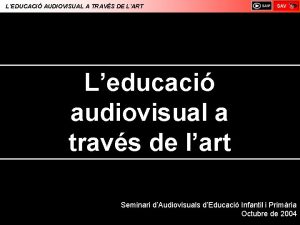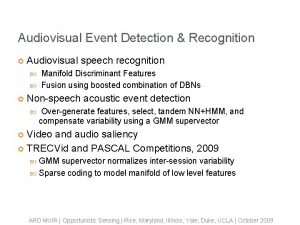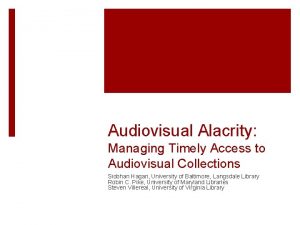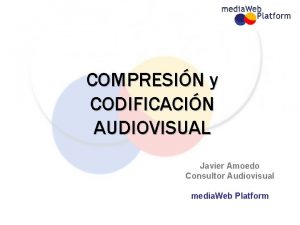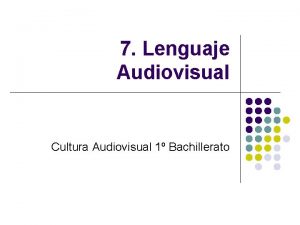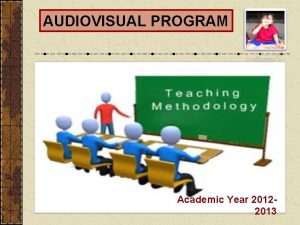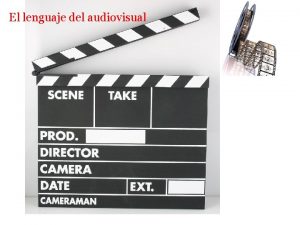Advances in Deep Audio and AudioVisual Processing ELEG




























- Slides: 28

Advances in Deep Audio and Audio-Visual Processing ELEG 5491: Introduction to Deep Learning Hang Zhou

Table of Contents ● Audio Representations ● Spectrogram Based Methods ● Wave. Net and Its Varients ● Audio-Visual Joint Learning 2

Audio Representations: Raw Audio Signals ● Audio data usually stored with information about Sampling Rate (e. g. 16000 Hz, with 16000 points a second), and Bits. Per. Sample (The scale that audio is saved, e. g. 2^16 for 16 bit) ● Raw audio contains important structure at many time-scales with an extremely high sampling rate of over 16000 points a second. 3

Audio Representations: Spectrogram ● Visual representation of the spectrum of frequencies of a signal as it varies with time. ● Short-time Fourier transform (STFT). 4 Tacotron: Towards End-to-End Speech Synthesis

Audio Representations: Spectrogram ● Mel-Frequency analysis of speech is based on human perception experiments. ● Filters are non-uniformly spaced on the frequency axis. ● Mel-Spectrogram. ● Mel-Frequency Cepstral Coefficients (MFCC) 5 http: //www. speech. cs. cmu. edu/15 -492/slides/03_mfcc. pdf

Spectrogram Based Speaker Verification ● CNN for speaker verification. (Audio classification) ● Input STFT of size 512 x 300 for 3 seconds of speech. 6 Vox. Celeb: a large-scale speaker identification dataset. INTERSPEECH 2017.

Spectrogram Based Recognition ● Speech recognition using bi. LSTM with attention. ● MFCC has been used for speech recognition for really long. 7 Lip reading sentences in the wild. CVPR 2017.

Spectrogram Based Super Resolution 8 Audio Super Resolution using Neural Networks. ICLR 2017 workshop

End-to-end Text-to-speech (TTS): Tacotron ● End-to-end generative TTS model based on the sequence-to- sequence (seq 2 seq). CBHG: convolution bank + highway networks + B-GRU Tacotron: Towards End-to-End Speech Synthesis 9

From Spectrogram to Audio: Griffin-Lim ● Spectrograms have only the magnitude part without the phase part. ● Griffin-Lim converges towards the estimated phase layer. Signal estimation from modified short-time fourier transform. Transactions on Acoustics, Speech, and Signal Processing 10

Wave. Net for Raw Audio Generation ● Deep neural network for generating raw audio. ● Fully probabilistic and autoregressive, predictive distribution for each audio sample conditioned on all previous ones. ● Provide a generic and flexible framework for tackling many applications that rely on audio generation. (e. g. TTS, music, speech enhancement, voice conversion, source separation) 11 van den Oord et. al. Wave. Net: A Generative Model for Raw Audio

Wave. Net Structure ● Fully convolutional neural network. ● No pooling layers in the network, output with same time dimensionality as the input. ● Convolutional layers have various dilation factors. ● Allow its receptive field to grow exponentially with depth. 12 van den Oord et. al. Wave. Net: A Generative Model for Raw Audio

Wave. Net Structure —— Casual Convolution ● Casual convolution, prediction cannot be made depending on future timesteps. ● No recurrent connections, typically faster to train than RNNs. ● Require many layers, or large filters to increase the receptive field. (Below has only the receptice field of 5) 13

Dilated Convolution 14 Multi-Scale Context Aggregation by Dilated Convolutions. ICLR 2016

Wave. Net Dilated Convolution ● Filter is applied over an area larger than its length by skipping input values with a certain step. ● Enable networks to have very large receptive fields with just a few layers. 15

Wave. Net Details ● Residual and skip connections. ● Training loss: 8 -bit mu-law encoding and predict each output step with a softmax over the resulting 256 values. 16

Conditional Wave. Net ● Model the conditional distribution ● Multi-speaker setting: conditioning on speaker information. ● In TTS: Use text as an extra input. ● Global conditioning (speaker) and local conditioning (text). 17

Tacotron 2: TTS with Wavenet and Mel Spectrogram 18 Natural TTS Synthesis By Conditioning Wavenet On Mel Spectrogram Predictions. ICASSP 2018

Wave. Net Autoencoder ● Learn a semantically meaningful hidden representation. ● Generate new types of expressive and realistic instrument sounds. 19 Neural Audio Synthesis of Musical Notes with Wave. Net Autoencoders. ICML 2017

Autoencoder-based Music Translation ● A domain confusion network that provides an adversarial signal to the encoder. ● Distorting the input audio by random local pitch modulation. 20 Autoencoder-based Music Translation. ICLR 2019

Autoencoder-based Music Translation https: //www. youtube. com/watch? v=vdx. Cq. NWTp. Us 21 Autoencoder-based Music Translation. ICLR 2019

Audio-Visual Joint Processing ● Audio-visual synchronizing. ● Audio-visual speech recognition. ● Audio-based video generation. ● Vision-based audio generation. ● Audio-visual source separation. ● And many more. 22

Audio-Visual Synchronizing 23 Out of time: automated lip sync in the wild. ACCV workshop 2016

Audio-Visual Synchronizing 24 Cooperative Learning of Audio and Video Models from Self-Supervised Synchronization. Ner. IPS 2018

Audio-visual Speech Recognition. 25 Lip reading sentences in the wild. CVPR 2017.

Audio-based Video Generation 26 You said that? BMCV 2017

Audio-based Video Generation 27 Talking face generation by adversarially disentangled audio-visual representation. AAAI 2019

Audio-visual source separation https: //www. youtube. com/watch? v=r. VQVAPi. JWKU Looking to Listen at the Cocktail Party: A Speaker-Independent Audio-Visual Model for Speech Separation. SIGGRPAH 2018 28
 Tally solutions pvt ltd
Tally solutions pvt ltd Short term loans and advances
Short term loans and advances Global oncology trends 2017 advances complexity and cost
Global oncology trends 2017 advances complexity and cost Deep asleep deep asleep it lies
Deep asleep deep asleep it lies Deep forest: towards an alternative to deep neural networks
Deep forest: towards an alternative to deep neural networks O the deep deep love of jesus
O the deep deep love of jesus Sound processing in python
Sound processing in python Audio processing using matlab
Audio processing using matlab Axis powers
Axis powers Advances in technology during wwii
Advances in technology during wwii Lesson 9.1 intellectual advances in the first year
Lesson 9.1 intellectual advances in the first year Advances in real-time rendering in games
Advances in real-time rendering in games Advances in mri
Advances in mri Opto-electronic advances
Opto-electronic advances Recent advances in dental ceramics
Recent advances in dental ceramics Non cdr standard restructured
Non cdr standard restructured Advances in memory technology
Advances in memory technology Education audiovisual and culture executive agency eacea
Education audiovisual and culture executive agency eacea Efficient processing of deep neural networks pdf
Efficient processing of deep neural networks pdf Deep processing ap psychology definition
Deep processing ap psychology definition Which of the following learning techniques is least likely
Which of the following learning techniques is least likely Levels of processing model
Levels of processing model Deep processing
Deep processing Point processing and neighbourhood processing
Point processing and neighbourhood processing What is primary processing of food
What is primary processing of food What is interactive processing
What is interactive processing Elementos de lenguaje audiovisual
Elementos de lenguaje audiovisual Instructivo audiovisual ejemplo
Instructivo audiovisual ejemplo Caracteristicas de la imagen audiovisual
Caracteristicas de la imagen audiovisual
